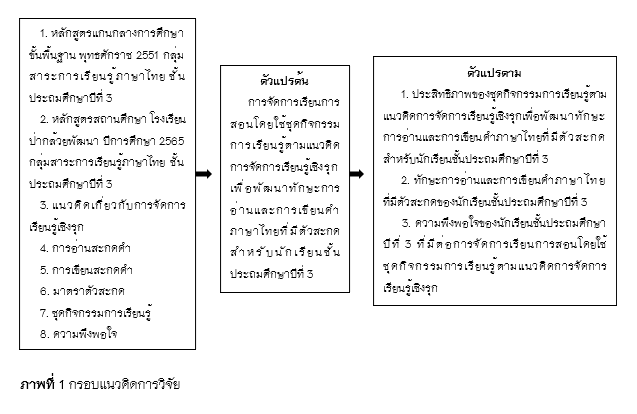The Construction of Learning Activity Package According to the Concept of Active Learning Management to Develop Skills in Reading and Writing Thai Words with Spelling for Students in Grade 3
Main Article Content
Abstract
The objectives of this research were 1) to study the basic information and needs to develop the learning activity package according to the concept of active learning management to develop skills in reading and writing Thai word with spelling for students in grade 3, 2) to create and find the effectiveness of the learning activity package according to the concept of active learning management to develop skills in reading and writing Thai word with spelling for students in grade 3, 3) to experiment with the learning activity package, and 4) Evaluate the effectiveness of a set of the learning activity package. The population was 17 students in grade 3 of Pakluay Pattana School in the academic year 2022 Research tools consisted of data recording form, questionnaire, Interview form, the learning activity package, reading and writing skills test and satisfaction questionnaire. The data were analyzed by using E1/E2, percentage, mean and standard deviation.
The results of the research showed that 1) Grade 3 students had problems in learning about reading and writing Thai words with spelling and wanting to has a variety of activities. 2) The learning activity package have 4 set; 1: Words spelling doesn’t meet MEA-KOK, 2: Words spelling doesn’t meet MEA-KOD, 3: Words spelling doesn’t meet MEA-KON, and 4: Words spelling doesn’t meet MEA-KOB. 3) The score of the Thai Reading and Writing Skills Test with spelling of students in grade 3 has an average score of 12.76 and after learning of 17.53. 4) The effectiveness of the learning activity has an E1/E2 value of 89.56/87.65, higher than the criterion of 85/85. Students had higher scores in reading and writing Thai words with spelling after studying than before studying. And have satisfied with the teaching and learning with the learning activity package with the highest level.
Downloads
Article Details

This work is licensed under a Creative Commons Attribution-NonCommercial-NoDerivatives 4.0 International License.
The articles published are copyrighted by the Graduate School, Chiang Mai Rajabhat University.
The opinions expressed in each article of this academic journal are solely those of the individual authors and do not reflect the views of Chiang Mai Rajabhat University or its faculty members. The responsibility for the content of each article rests entirely with the respective authors. In the event of any errors, the authors alone are responsible for their own articles.
References
Dethfang, P. (2020). The development of a cooperative learning activity package using STAD technique entitled. (Master’s thesis, Curriculum and Instruction Pibulsongkram Rajabhat University). [In Thai]
Iamsrichanchai, K. (2017). A development of a Thai remedial reading package for prathomsuksa 2 students. (Master’s thesis, Curriculum and Instruction, Thepsatri Rajabhat University). [In Thai]
Jamjan, W. (2020). A study on reading and writing abilities in Thai language for prathomsuksa 1 students from learning management through Thai language reading and writing exercises. (Master’s thesis, Curriculum and Instruction, North Bangkok University). [In Thai]
Keawsritrai, S. (2020). Development of Thai language learning activity sets for communication About words and their functions by using active learning management for grade 6 students. (Master’s thesis, Curriculum and Instruction, Sakon Nakhon Rajabhat University). [In Thai]
Khowtrakun, S. (2021). Educational psychology. (13rd edition). Bangkok: Chulalongkorn University Press. [In Thai]
Laoriandee, W., Kitrungrueang, P., and Sirisamphan, 0. (2017). Proactive learning management strategy to develop thinking and raise the level quality education for the 21st century. (12nd ed.). Nakhon Pathom: Phetkasem Printing Group. [In Thai]
Mahakhan, P. (2019). Principles of teaching Thai language in elementary school. (12nd edition). Bangkok: Teachers Council Printing House. [In Thai]
Ministry of Education. (2013). Basic education core curriculum, 2008. Bangkok: Printing House of the Agricultural Cooperatives Association of Thailand. [In Thai]
Pakluay Phattana School. (2021). Self-assessment report: SAR, 2021. Chiangmai: Pakluay Phattana School. [In Thai]
Phengsawat, W. (2019). Classroom research. (5th ed.). Bangkok: Suwiriyasat. [In Thai]
Satuwichan, A. (2020). The effects of a set of reading and writing comprehension learning activity on prathomsuksa 1 student’s Thai reading and writing ability. (Master’s thesis, Curriculum and Instruction Rajabhat Rajanagarindra University). [In Thai]
Satyopas, S. (2013). Teaching Thai language at the basic education level. Bangkok: Publisher Bannakit 1991 Co., Ltd. [In Thai]
Sayjeen, J. (2019). Learning activity package on professional learning community concept in Thai language subject for primary 6 students. (Master’s thesis, Educational Technology and Communications Rajamangala University of Technology Thanyaburi). [In Thai]
Sinthaphanon, S. (2017). Innovative teaching and learning to develop the quality of youth. (5th ed.). Bangkok: 9119 Technique Printing. [In Thai]
Somngam, Y. (2016). Development of activity sets to promote Thai reading skills for grade 1 students. (Master’s thesis, Curriculum and Instruction, Thepsatri Rajabhat University). [In Thai]
Thurarat, A. (2015). Development of activity sets on spelling rules, Thai language learning subject group Grade 3 by organizing brain-based learning activities. (Master’s thesis, Curriculum and Instruction Sakon Nakhon Rajabhat University). [In Thai]
Upakitsinlapasan, P. (2002). Thai language. (11st ed.). Bangkok: Thai Wattana Panich. [In Thai]
Uporanai, P. (2018). Teaching science. (15th ed.). Bangkok: Victory Power Point. [In Thai]
Wonglekha, F. (2019). Be able to read and write 100%, not beyond your dreams. (7th ed.). Bangkok: Daily News Printing House. [In Thai]
Wongsiri, S. (2012). Developing activity sets to promote creativity in writing imaginative stories Thai language learning group for 3rd grade students. (Master’s thesis, Curriculum and Instruction Thepsatri Rajabhat University). [In Thai]
Wongtip, K. (2021). Thai language. (3rd edition). Chiang Mai: Triple P Print and Place. [In Thai]


